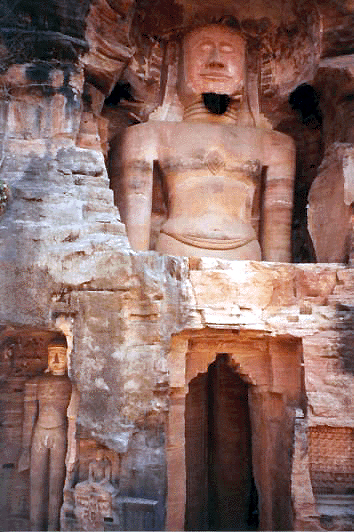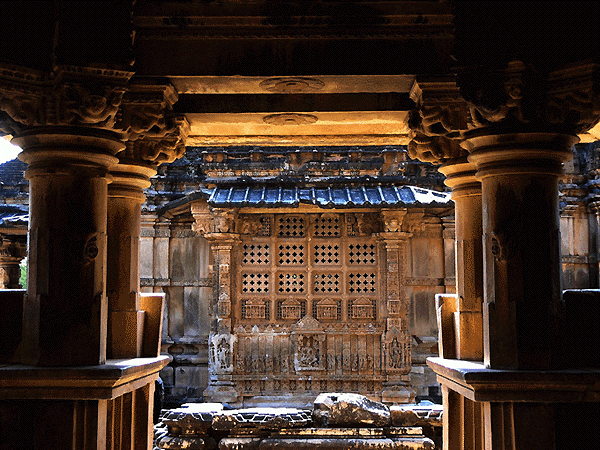
|
|
|
|
A Jain temple in the complex is dedicated to Adbhutji, and houses a 9 foot tall murti of their saint Shanti Nath. The Saas-Bahu and Teli-Ka temples are dated to the late 10th century, and while part of the larger Jain complex, are more in the Vaisnava mood, as both are dedicated to Lord Visnu. In fact, this complex is characteristic of Gwalior, which has become known as a center for religious tolerance. Here, the Vaisnavas, Jains and Sikhs live peacefully with the Muslims, Christians and even the Theosophists.
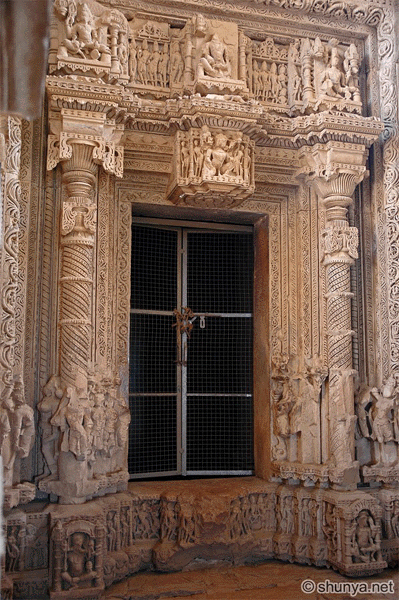
Saas-Bahu Temple
The Saas-Bahu is really a twin temple, both replete with architectural splendor. They are intricately carved and ornamented, with many temple sculptures. Known as the temples of the mother-in-law and daughter-in-law, the Sas (mother-in-law) temple is much larger than the Bahu (daughter-in-law). It has an arched torana entranceway, and a murti of Visnu has sometimes been swung from the torana on religious occasions.
The temples are placed on a common raised terrace, facing east towards a tank. 10 smaller shrines surround the temple of Sas, while Bahu is surrounded by four shrines. Both the temples have the same floor plan. Each has a sanctum sanctorum, mandapa (columned prayer hall), and porch. The walls are fairly plain, with beautiful sculptures on the main projections. These sculptures are positioned in two tiers, with Lord Visnu, Brahma, and Shiva, surmounted by Rama, Balarama and Parashurama, respectively.
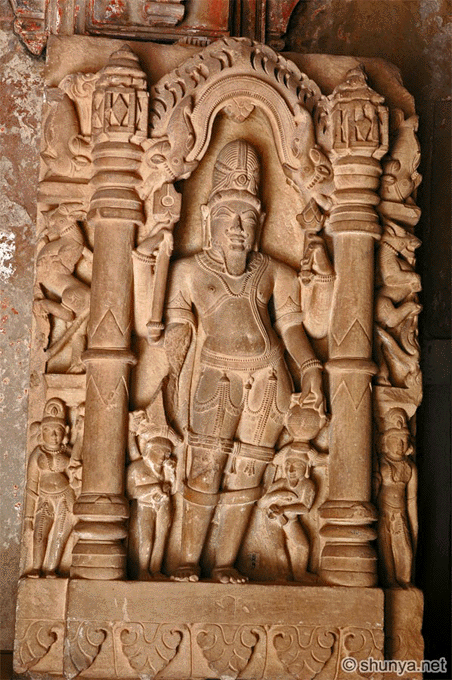
Lord Brahma, Saas-Bahu Temple Though in ruins, the brick towers have many turrets. The mandapas and porches are highly decorated with sculptures and ornamental motifs, which are beautifully contrasted by the smooth sanctum walls. Other carved images include the Dikpalas, narrative friezes, and scenes from Ramayana. The columns are also richly ornamented. While the Brahma murti here is not the predominant deity, it is so exquisite in form that it serves as a place of worship for devotees.
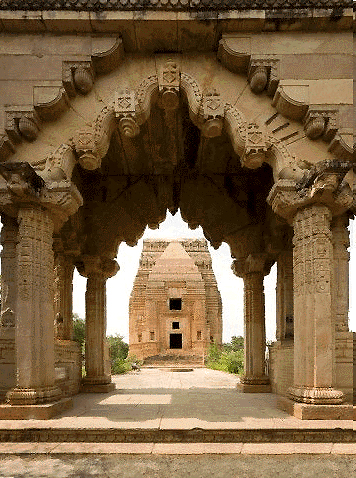
Teli-ka Mandir
Teli ka Mandir is though by many to be one of the most exquisite temples in all of Madhya Pradesh. Built in the 9th century, the architecture is a unique blend of the Dravidian and North Indian (Nagara) styles. Dedicated to Lord Vishnu, the temple is filled with excellent sculptures of Yamuna and Ganga Devis, Nagas, Devatas, and Garuda. The structure is 100 meters tall, and the 10 meter entrance is crowned with a beautiful Garuda. Located within the confines of the Gwalior Fort, This Rajput temple is thought to have gotten its name during the occupation by Rashtrakuta Govinda III in 794 A.D., when the Telang Brahmins were given supervision of all religious ceremonies in the complex. All around the Teli-ka and Saas-Bahu are many colossal Jain figures, cut into the fine-grained yellow sandstone and elaborately ornamented.
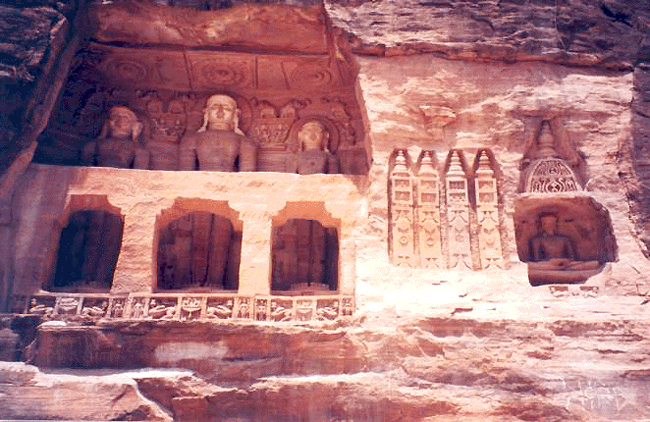
Jain Murtis, Saas-Bahu The Saas-Bahu has a taller moulded plinth than the Teli, and seems to have been more elaborately carved, and most every surface is covered. The work above the lintel is outstanding. There are projected and multi-layered small versions of single-storey pillared shrines along the wings, and these house various murti carvings. One of the most famous of these is a stunning Lord Brahma, commonly known as the "bearded Brahma", in the Bahu temple. The upper apartment is occupied by Vishnu and Laksmi Devi, with Garuda beneath.
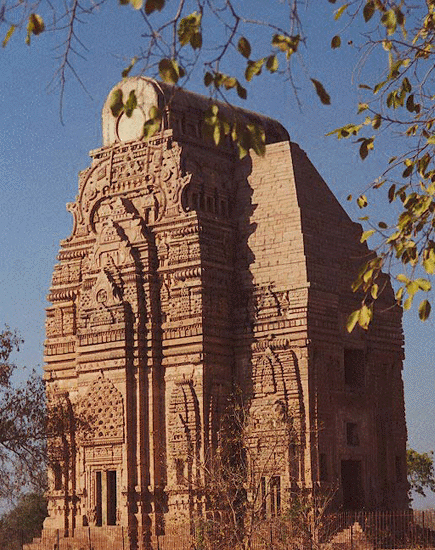
Teli-ka Mandir In understanding the convergence of religious influences in this place, it is interesting to read this description of Saas-Bahu by Arun Gaur: "It is fortunate that we have the detailed epigraphical foundation inscription of Mahipala (A.D. 1093) that states many facts, and leaves many questions unanswered. The inscription helps in unravelling the underlying structural and iconographic conceptions. In it, Padamanatha has been named the principal deity, which is apparently derived from the Kachchhapghata prince Padamapala. The two kings had their own preferences and none could have been ignored. These two deities were Vaikuntha and probably Aniruddha.
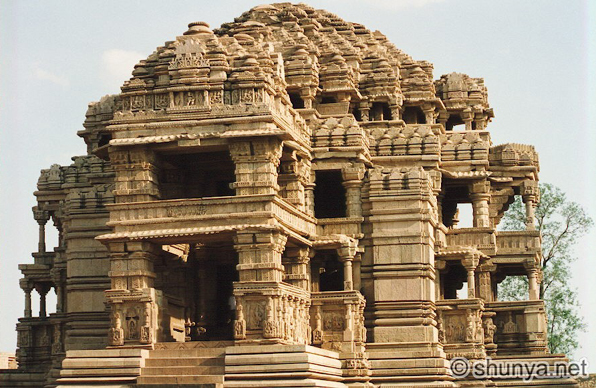
Saas-Bahu Temple Along with the Vaikuntha, two images of Aniruddha have been referred to in the inscription — one made of pearl and the other of silver. The pearl Aniruddha had grown a little due to the pangs of separation from his consort Usha. Some commentators infer from this reference that female deities were not set up. The images of silver Aniruddha, Achutya and Vamana were, perhaps, installed in the smaller temple and those of pearl Aniruddha and Vaikuntha in the larger. The inscription further tells us that the temple was conceived as a rival to the Kailasha mountain. Was it a kind of Vaishanava challenge to the Shaiva sect in the 10th century? Its pennant, white as the moon, streamed down the summit like the Ganga descending into the thoroughly matted hair of Shankara. May be, an idea like this is responsible for the condensed, thickly set mass of the shikhara — a rising succession of turrets on the inverted bell of superstructure. For rituals Padamapala had appointed eight Brahmins, the number was later increased to 18 or 21 by Mahipala who also made arrangements for the dancers, musicians, lighting, ornaments and vessels."
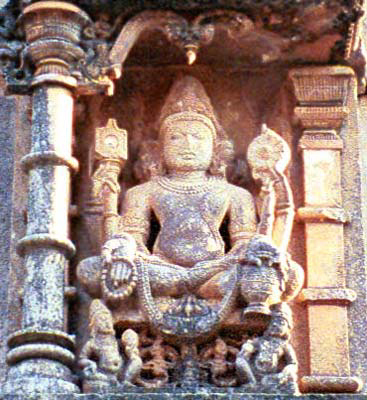
Lord Brahma, Saas-Bahu
| |
